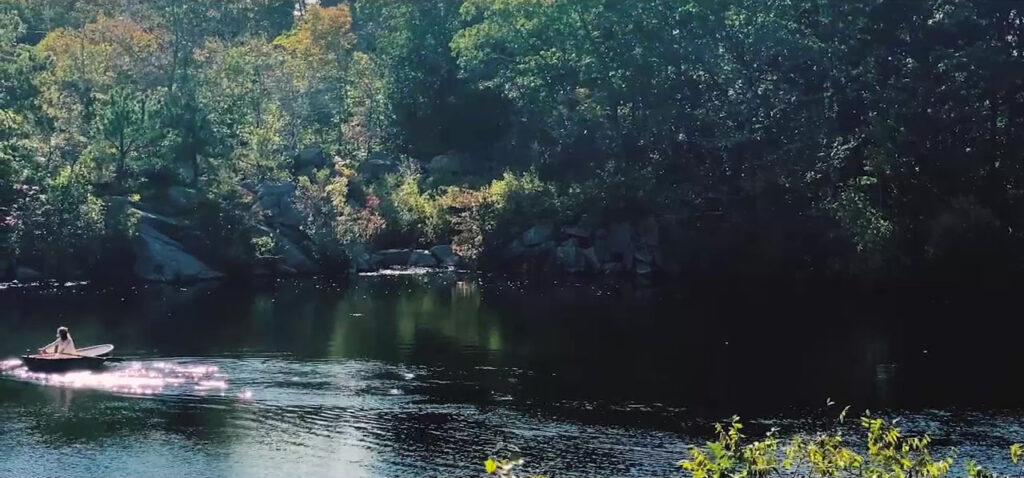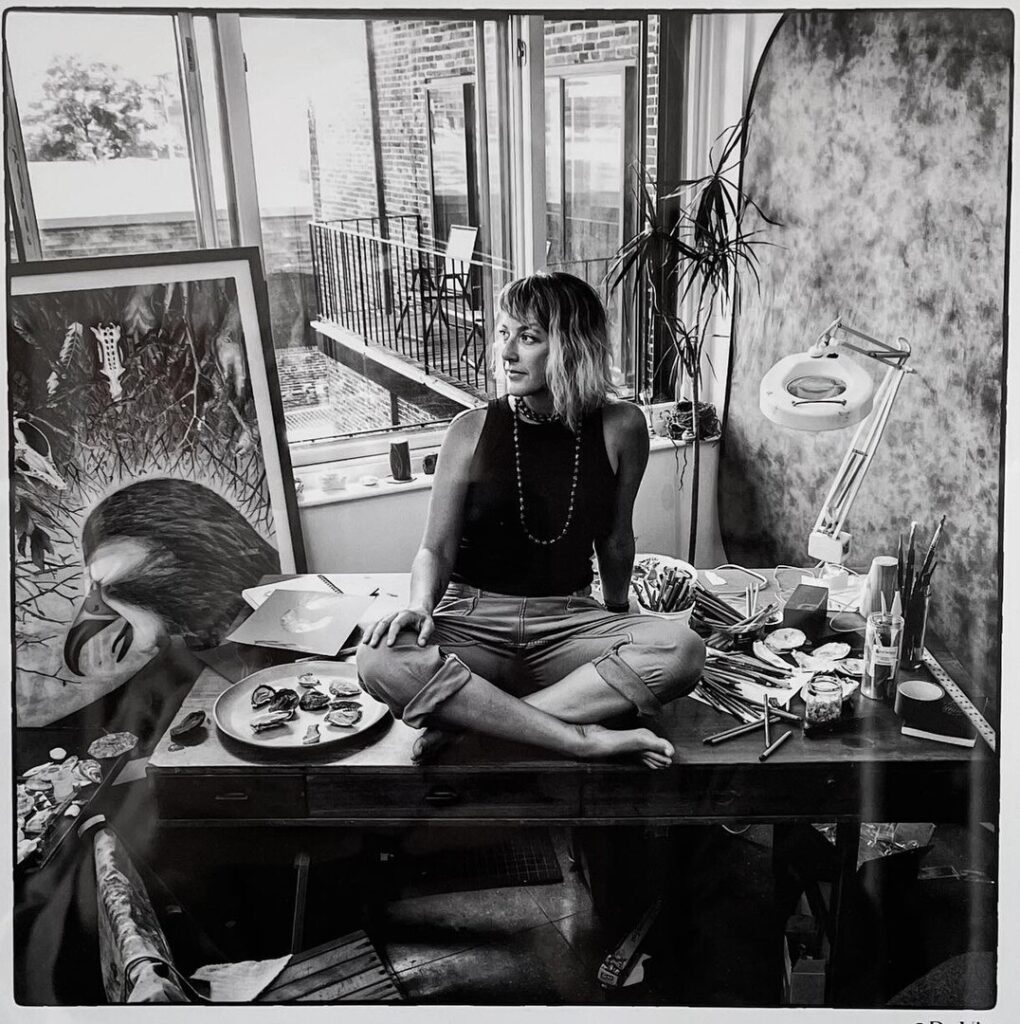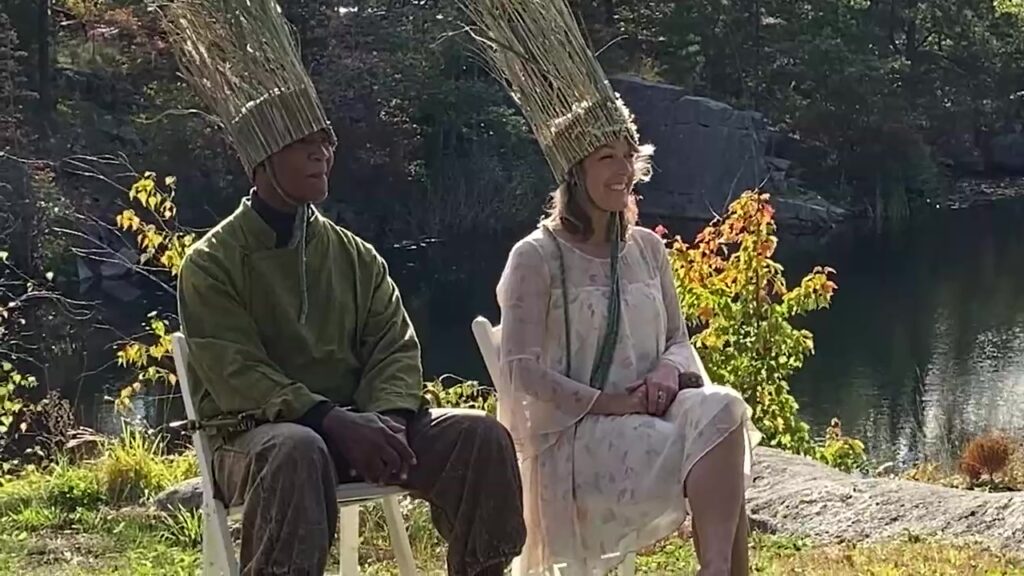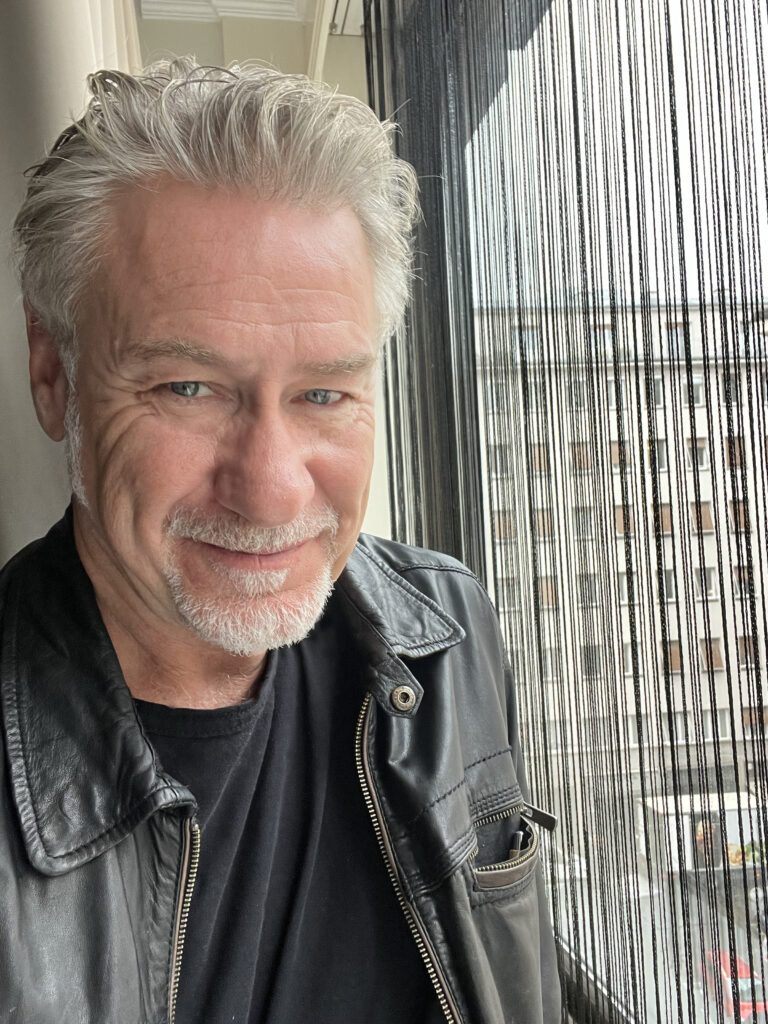
Spirit Sensing: Anima of the Quarry is a captivating performance film created by artist Kyle Browne, musician Stan Strickland, and editor/producer Ken Kinna. Set in a reclaimed quarry, the film explores themes of embodied consciousness, animism, and the natural world. Browne discusses the magic she discovered in the quarry’s energy, the influence of Druidic beliefs on her artistic vision, and the powerful feminine archetypes and spiritual practices that shape her work. Kinna shares how he helped craft the film’s rhythm and immersive atmosphere, enhancing its meditative and transformative experience.
Questions to artist and director Kyle Browne
Your work explores layers of embodied consciousness, the wisdom of the natural world, and archetypal wildness. Can you share how these themes informed the creation of “Spirit Sensing: Anima of the Quarry”?
Kyle: When I approach a site-specific work I consider the histories and narratives it holds – natural, historic, social and energetic. I believe all of these together create a consciousness of place that can be unearthed and applied to artistic expression. A quarry holds many layers interwoven with industry and restoration, a human conquest, reclaimed by water, stone and sky to create a thriving environment for many species. It has a story to tell, full of insight and wisdom – yet only if we listen through all our senses, can we hear.
The film is described as an “intuitive performance” within a specific site. Can you walk us through your creative process while at the Manship property, and how the quarry influenced the direction of the project?
Kyle: When I was at the Manship, my intention was to find the ‘magic’ of the place. This led me to explore the property through an internal felt sense to understand its energy. There are two freshwater quarries on the property, which I swam and paddled in daily. I observed the flora, fauna, quality of light and natural effects, intimately. The reflections and light distortion of water always transported me to a parallel dream-like world.
The crown that you see in the film was first crafted as a sensory device to enhance the flow of energy to my crown chakra. I used quarry reeds as the conduit, due to their height and sensitivity to air. It was fascinating to feel their subtle swayings in the wind when worn.
Stan Strickland and I serendipitously overlapped on his last night of my second residency stay. When he suggested we collaborate, I was enticed. I called him a week later with the idea of ‘Spirit Sensing’ and performing on the quarry together, little did we know it would take on a life of its own.
How did your collaboration with musician Stan Strickland shape the final outcome of the film? What was it like working with him?
Kyle: Stan is the pure embodiment of a performer, I am honored to collaborate with him. His experience with theater helped give the performance a shape and structure so I could let my intuitive nature come forth. The interaction of our energies created a field for all the elements to come together in an effervescence of delight.

The film draws on Druidic beliefs and animism, suggesting that nature has a soul or consciousness. How did you ensure that these cultural and spiritual elements were respectfully and authentically represented in the film?
Kyle: Stan and I both have ancestral heritage from Ireland where the Druid practice originated from ancient Celtic wisdom. Modern Druidism is a constantly evolving belief system that draws from the lessons of the living earth. For instance, the three main elements we honored and collaborated with – the sky, water and stone – are primary to the Druid elemental system. Each of these elements correlates with symbols, colors, seasons and myth. It also employs ternary thinking which can be much more harmonious than common binary perceptions. Yet, Druids also work with polarities that weave together masculine and feminine energies, which they call telluric (earth) and solaric (sun). An individual human being makes up the third factor which neutralizes that binary – and any living thing can fill that role. The living thing then becomes the conduit for a lunar current which when generated in an individual is represented by the crown of the head to bring healing, creativity and expanded awareness.* In our artistic research for the performance and film, we listened and worked closely with the elements, even intimately crafting with them. I created a crown from quarry reeds to help channel energies, which we used as a feature in the film. Humans have tried to understand the phenomenal world to be nourished by it, oftentimes in ways that are only extractive, as exemplified by the quarrying industry. Our intention was to work in collaboration with the elements, in a symbiotic relationship. Observations of wonder from the audience after the live performance confirmed this experience – the way the sun came out from the clouds to shine rays on us, or the wind rippled the water at just the right moment – it was truly magical. Although that immersive environment is difficult to replicate through a film, we hope it transports people to consider how to learn and best interact with the phenomenal world.
*informed by The Druidry Handbook: Spiritual Practice Rooted in the Living Earth by John Michael Greer, 2006
“Spirit Sensing” is designed to invite viewers into a sacred space. How do you hope audiences will interact with and interpret this space, especially given the absence of dialogue?
Kyle: This is an interesting question, because in its nature, watching a film is passive. We hope that passivity can be shifted to receptivity and people will discover a connection to the elements of earth, sky and stone as well as the interconnectedness of all things. We’d like them to question what Dr. Clarrisa Pinkola Estes calls the ‘over-culture’, the hierarchy of the rational mind and to consider the non-human experience. They are invited to let go of the ‘otherness’ in regards to separateness from the natural world and be moved to authentically embody their own true natures.

You’ve mentioned that your vivid dreams and spiritual practices often inspire your work. Were there specific dreams or spiritual experiences that directly influenced “Spirit Sensing: Anima of the Quarry”?
Kyle: Stan and I both have spiritual practices that inform our work. Stan is influenced by gospel music and we both have participated in and are inspired by Indigenous and Native American ceremonies. The ceremonies are collective offerings and expressions of gratitude to our ancestors and the natural world – to remember what they have taught us. I have learned to pay closer attention and trust the unseen. This work around ritual influenced my reverence when engaging with natural objects and the quarry. The performance was an invitation to share in that reverence and create a sacred space to collectively wonder, heal and imagine.
Your work frequently engages with themes of the feminine. How does “Spirit Sensing” reflect or expand on your exploration of the feminine archetype?
Kyle: Spirit Sensing expanded my exploration of the feminine by moving me into a different discipline and completely trusting my intuition. Although I danced when I was young and employ performative research in my practice, this was the first professional performance I directed and performed for a live audience. It was a seachange in terms of allowing my work to be truly embodied, and a very powerful one. The act of creating, as well as creation stories, are also inherently feminine, a birthing of ideas and expressions which didn’t exist before. Collaborating with Stan also brought up the discussion of the interaction of our feminine and masculine energies. Stan has experience with Chinese medicine, and in that practice there is an innate integration of the two – the male form, although bigger boned and muscular, holds the vulnerability of the feminine within; and the female form, although usually more delicate, holds the strength of the masculine.
This film represents a unique blend of performance art, nature, and spirituality. How do you see this project influencing your future work? What themes are you eager to explore next?
Kyle: The power of movement to express ideas, and share that immediacy with others is something I want to continue to explore. I have a clearer understanding of how corporeal information is a conversation with oneself and others to create deeper connections. The making of the film has also influenced a deeper awareness and reflection into my Celtic heritage and the practices of Druids – which is intrinsically aligned to my own personal belief system, something that I don’t think is a coincidence. For Stan, this has demonstrated the power of enactment as a ritual in conjuring the consciousness of spirit as part of our ancestral memories. And in that enactment to understand we are analog beings in a digital world. We also hope to collaborate again and bring our perspectives and expressions to other projects and artist residencies.
Questions to editor and producer Ken Kinna
How did you first become involved in “Spirit Sensing: Anima of the Quarry,” and what drew you to this unique concept?
Ken: I am on the Board of the Manship Artists Residency in Gloucester, Massachusetts, where Kyle Browne and Stan Strickland met and collaborated on this meditative public performance as a program offered during an outdoor exhibition entitled CONTINUUM: Cape Ann Sculpture Today. Though I often film interviews and conversations with our resident artists and create videos of events at the Residency, I was away when this performance happened. We were fortunate that Jack Davies, who works at Little Art Cinema in Rockport nearby, offered to come and get it shot. I had expected this would become a basic piece documenting a performance. But as I reviewed the footage, it was clear that Jack had captured something very special and that we had a short film. It was simple but enchanting. Set on a beautiful October day, the piece spoke to a universal connectedness between the land, water, rocks, trees, birds, and ultimately, between all of us to each other. This short film gives us a chance to look just differently enough at a simple story. And with Stan, who is an amazing multi-instrumentalist and movement therapist, playing the music, it had his unique sense of spirit that drove the piece with Kyle’s vision and grace. Plus, a good sound track makes the piece. It’s scale also drove me to get into 5.1 Surround Sound and ultimately ATMOS adding another layer to this narrative film without dialog. I also felt the absence of language naturally made it universal to all places where you can still play a short art film, like VIFF! Thank you for providing this opportunity to share this spirit sensing experience with an international audience.
Were there any moments where the input of Kyle Browne and Stan Strickland significantly influenced your editorial choices?
Ken: Kyle as artist/actor/director did a great job reviewing cuts, giving notes and keeping to her vision in the film. I pushed ideas and restrained definitions. I definitely believe the Director and Editor need to drive each other to make the best choices for a film. Stan’s instrumentation along with Bob Toabe on bells drives the piece further with live and post-recorded music.

How did you interpret and translate the concept of “anima” into the pacing and structure of the film?
Ken: There is a long tension of “sensing” as the environment reveals itself. Sounds and images are simple but become more heightened to a crescendo of connection and resolution of rhythmic life and an ultimate reconnection to the Earth. Anima is an ancient concept from our distant hunter-gatherer selves, and whether what Kyle and Stan found was from nature, their Celtic past, Scandinavian, Nordic, and/or North European ancestry, or from the Native American spirit that still inhabits this land, it all seems to be just right depending on your perspective.
How did you handle the challenges of editing a film with no dialogue or traditional narrative structure? Did this require a different mindset or technique compared to more conventional films?
Ken: The visuals of a story must tell the story so there is not much difference in editing approach, only that it had to stay in one flow and maintain a sense of isolation and magic. I did need to enlist the expertise of my close friend Anthony Siarkiewics, whom I had worked with when he was in New York. Now living in Frankfurt, Anthony contributed his special effects magic to remove unwanted modern scenery like trucks parked in inappropriate places. Other issues like the wind and wild sound had to be removed and recreated but this offered an opportunity for creative solutions.
As both the producer and editor of “Spirit Sensing: Anima of the Quarry,” how did your dual roles influence the overall creative direction and production decisions of the film?
Ken: Most of my influence was in post production, in weaving together the multiple clips, and enlisting the necessary resources to compose a finished piece. Beyond that, I felt it was my job to take what Kyle and Stan created with Manship Artists Residency and make it into a visually and emotionally compelling film and ensure it would get out into the world and find its receptive audience.
The absence of dialogue places a significant emphasis on editing to convey the film’s rhythm and flow. Can you describe your approach to editing this film and how you maintained its meditative and immersive quality?
Ken: Maintaining the meditative, still, and immersive quality and also expanding its dynamic range was a challenge. And even though my first cut was pretty fast and intuitive, the only way to really ensure you have it is to review and refine obsessively… and then realize there is always so much more you can do.
What do you hope audiences will take away from “Spirit Sensing: Anima of the Quarry”? How do you think this film stands out in today’s landscape of experimental cinema?
Ken: I hope it will open their senses and enable a simple alternative view of reality, one that looks at life with a gracious wonder and connection as a direct alternative to the hell we impose on one another under the constructs of national borders, the fear of ethnic differences, attachment to generational hatred perpetuated by religions or misdirections of politics. Artists must present a different vision.
I deeply believe in the power and necessity of art in our lives, but as more than a nice to have, as a must have. Creative solutions come from people prepared to think differently and those thoughts can become the reality of our collective community. I think of Mozart who breathes life and economy into such cultured cities as Vienna and Salzburg every day. However, we must remind ourselves that this beloved artist was treated much like a servant and was thrown into a pauper’s grave. In America, we still underfund the arts and need reform. One reason I wanted to release this little film in Vienna is because I have always loved this city. As a teenager, while visiting my grandmother, I drank coffee at the Museum Cafe. I also was enchanted with the Vienna Secession building of Joseph Maria Olbrich’s and took its inscription to heart, “To every age its art. To art its freedom.” Though written in a different context, these words are even more true today. Artist residencies help to provide this freedom to creative thinkers and makers who produce work that serves as a vehicle to connect us and shift our perspectives, helping us envision a new way to move forward together. Artists reflect our past, expose our present, and guide us into the future. They deserve our support.
Official website of Kyle Browne – http://kylebrowne.com/
Official website of Ken Kinna’s B-Roll Films – https://www.b-rollfilms.com
